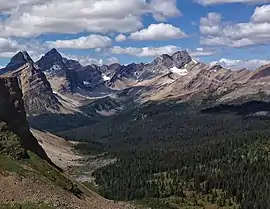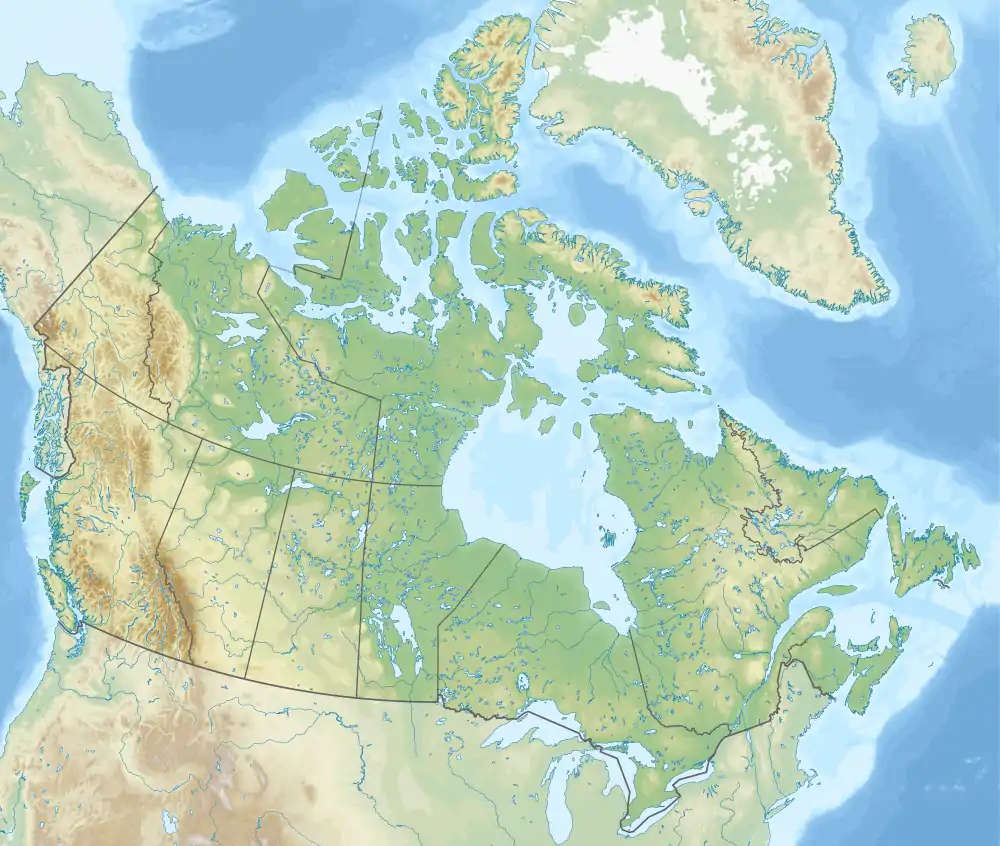Watermelon Peak
Watermelon Peak is a 3,094-metre (10,151-foot) summit located in Banff National Park, in the Canadian Rockies of Alberta, Canada. Its nearest higher peak is Deluc Peak, 13.5 km (8.4 mi) to the east.[1]
| Watermelon Peak | |
|---|---|
 Watermelon Peak seen from Molar Pass with summit to right of center and outlier S2 to left | |
| Highest point | |
| Elevation | 3,094 m (10,151 ft) [1] |
| Prominence | 674 m (2,211 ft) [1] |
| Parent peak | Deluc Peak (3182 m)[1] |
| Listing | Mountains of Alberta |
| Coordinates | 51°42′56″N 116°20′35″W [1] |
| Geography | |
 Watermelon Peak Location of Watermelon Peak in Alberta  Watermelon Peak Watermelon Peak (Canada) | |
| Location | Banff National Park Alberta, Canada |
| Parent range | Canadian Rockies |
| Topo map | NTS 82N09 |
| Geology | |
| Age of rock | Cambrian |
| Climbing | |
| First ascent | 1966 D. Michael, W.V.G. Matthews, W.L. Putnam, M. Stearns, L.R. Wallace[2] |
| Easiest route | Scrambling YDS 3[3] |
History
Watermelon Peak was named in 1966 by William L. Putnam, member of the first ascent party which carried a four kilogram watermelon to the summit, and consumed it there.[4] The July 1966 first ascent party included David Michael, W.V.G. Matthews, William L. Putnam, M. Stearns, and L.R. Wallace.[2]
Geology
Like other mountains in Banff Park, Watermelon Peak is composed of sedimentary rock laid down during the Precambrian to Jurassic periods.[5] Formed in shallow seas, this sedimentary rock was pushed east and over the top of younger rock during the Laramide orogeny.[6]
Climate
Based on the Köppen climate classification, Watermelon Peak is located in a subarctic climate zone with cold, snowy winters, and mild summers.[7] Temperatures can drop below −20 °C with wind chill factors below −30 °C. Precipitation runoff from Watermelon Peak drains into the Bow River and Siffleur River which are both tributaries of the Saskatchewan River.
References
- "Watermelon Peak". Bivouac.com. Retrieved 2019-01-10.
- "Watermelon Peak". PeakFinder.com. Retrieved 2019-09-08.
- "Watermelon Peak". explor8ion.com. Retrieved 2019-09-08.
- Boles, Glen W.; Putnam, William Lowell; Laurilla, Roger W. Canadian Mountain Place Names: The Rockies and Columbia Mountains. Rocky Mountain Books. pp. 265-266. ISBN 9781894765794.
- Belyea, Helen R. (1960). The Story of the Mountains in Banff National Park (PDF). parkscanadahistory.com (Report). Ottawa: Geological Survey of Canada. Archived (PDF) from the original on 2015-10-02. Retrieved 2019-09-13.
- Gadd, Ben (2008). Geology of the Rocky Mountains and Columbias.
- Peel, M. C.; Finlayson, B. L.; McMahon, T. A. (2007). "Updated world map of the Köppen−Geiger climate classification". Hydrol. Earth Syst. Sci. 11: 1633–1644. ISSN 1027-5606.
External links
- Parks Canada web site: Banff National Park
- Climbing Watermelon Peak: Golden Scrambles
